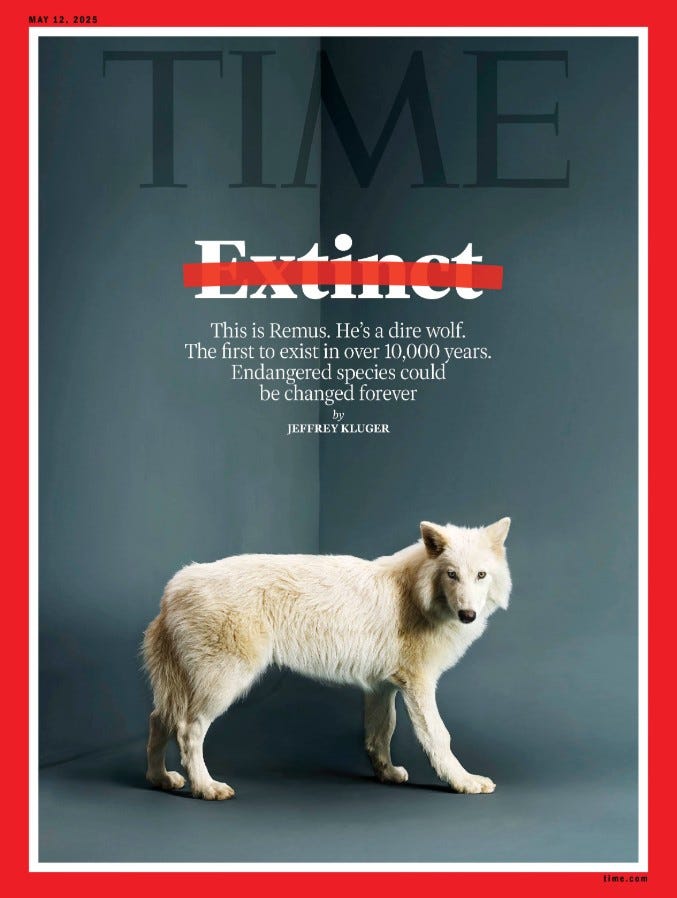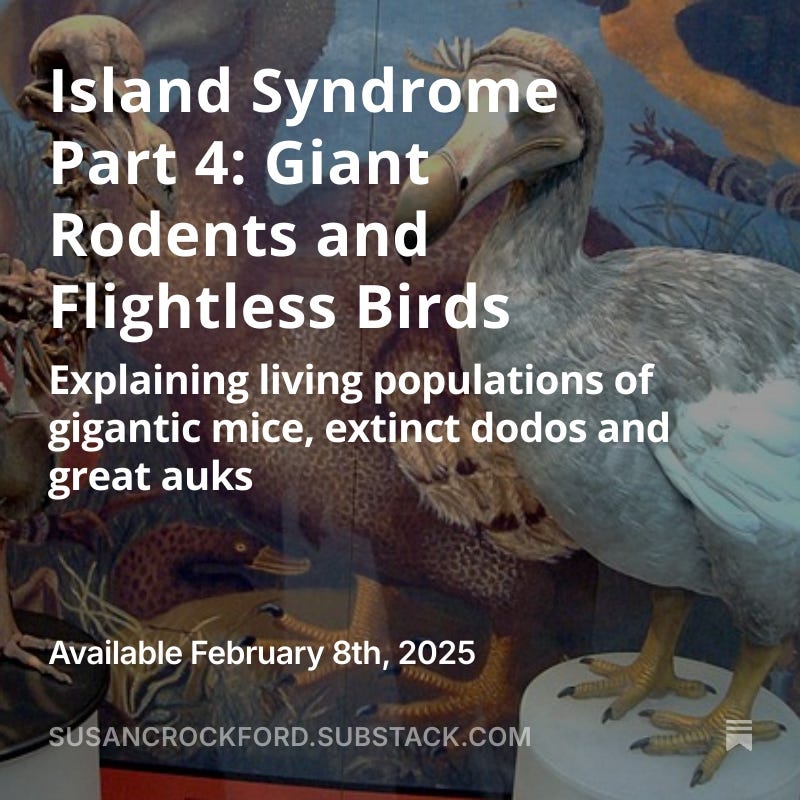Still No Living Dire Wolves
Overblown claims focus on genes and ignore the hormones of fetal development
Just a short post as I continue to heal, resorting to more quotes than I usually would. However, I just had to comment on this media-hyped nonsense that a biotech company called Colossal Biosciences has brought the American dire wolf back from an extinction event that took place at least 10,000 years ago.
They’ve done nothing of the sort, of course, as those of you who’ve been reading my essays over the past few months might have already concluded.
It’s all based on a story that appeared in Time Magazine—not a scientific paper—that reads more like a press release than a reasoned piece of work from a journalist.
What the researchers at Colossal did was identify 14 dire wolf genes taken from two degraded ancient DNA samples (one 13,000 years old, the other 72,000 years old) that were different in 20 places from grey wolf and which they thought were associated with significant species traits, especially fur colour and body size, as well as tooth and jaw configuration. They then made artificial replicas of those gene sequences and switched them in for the corresponding genes in a complete grey wolf genome.
In other words, they essentially performed a ‘gain of function’ manipulation of a grey wolf genome and falsely declared the product a ‘dire wolf’ genetic sequence.
Following protocols for cloning, as I described in my February 2025 post on the topic, they implanted three genetically-modified eggs with the manipulated grey wolf genome into three domestic dog surrogates (some mix of large hound breed, selected for large size) and declared the resulting offspring to be dire wolves resurrected from extinction.
Two of the resulting male pups (called Romulus and Remus) are now six months old and the third, a female, is two months old. According to testimony provided on April 7 by Colossal:
Romulus and Remus are doing what puppies do: chasing, tussling, nipping, nuzzling. But there’s something very un-puppylike about the snowy white 6-month olds—their size, for starters. At their young age they already measure nearly 4 ft. long, tip the scales at 80 lb., and could grow to 6 ft. and 150 lb. Then there’s their behavior: the angelic exuberance puppies exhibit in the presence of humans—trotting up for hugs, belly rubs, kisses—is completely absent. They keep their distance, retreating if a person approaches. Even one of the handlers who raised them from birth can get only so close before Romulus and Remus flinch and retreat. This isn’t domestic canine behavior, this is wild lupine behavior: the pups are wolves. Not only that, they’re dire wolves—which means they have cause to be lonely.
Colossal’s manager of animal husbandry added:
“They have different personalities,” says McNickle. “Romulus was a very brave pup and the first to go exploring on his own even when he was just a few days old. Remus was much more reserved and would follow Romulus’ cues. As they are growing up, Remus has become the more confident of the two and the first to explore new things and new areas.”
So, as for the examples I gave in my ‘cloning’ essay, these two animals are showing individual differences in behaviour despite being genetically identical. What other differences are as yet undiscovered—or which they are not telling us about? There were no photos provided of the younger female pup, which seems rather odd. How different is she from the two males?
In addition, none of the Colossal scientists explained why the two older pups are white. The dire wolf was certainly an Ice Age species, but I don’t recall ever before seeing any indication that we should have expected them to be snowy white. In ecological terms, there seems little evolutionary rationale for such a colour scheme unless these animals were exclusively ice-edge hunters, which I’ve never seen suggested.
A few white wolves exist in all grey wolf populations, of course, but only for Arctic wolves in North America is white is the dominant colour.
Geneticist Jerry Coyne had this to say [my bold]:
My general sentiments are these: attempts to bring back extinct species as outlined so far are not only scientifically misguided, but are journalistically mis-reported by the press. That is, the press is, by and large, distorting what has been done scientifically, pretending that an animal with only a few cosmetic gene edits is actually identical to an extinct species. Further, Colossal seems happy enough to let this misconception be widely reported (to be fair, there are some decent articles about the science of de-extinction, and I’ll link to a few below).
The main problem, as I said, is the pretense that changing a living species by editing just a handful of genes (20 max so far) to get something that looks like the extinct “dire wolf” is not the same thing as re-creating a dire wolf. That species undoubtedly had hundreds or thousands of genetic differences from the gray wolf, including genes affecting metabolism and behavior—genes that we do not know. Further, control regions of genes, which are outside protein-coding regions, undoubtedly are involved in differences between extinct species and their relatives. But we don’t know where these regions are and so cannot use them for genetic editing.
All of this means that, in my view, de-extincting species is a cosmetic rather than a serious genetic project, designed to produce gee-whiz animals to entertain rich people and to wow children. Such animals, especially the highly touted de-extincted mammoth, which mammoth expert Tori Herridge calls “an elephant in a fur coat”, would certainly not survive in their original habitat. Further, proponents’ claims that de-extinction would be a fantastic conservation effort , and could even mitigate global warming. are totally unsupported speculations.
You’ll notice, I hope, that all of Coyne’s concerns—all perfectly valid—are nevertheless about genes and their composition, with no mention of the control of genetic function by thyroid hormones during the extraordinary growth and brain development that occurs during the fetal period, a known fact which few (if any) geneticists seem to be aware.
This is why I contend that these ‘dire wolves’ are actually hybrids between a genetically-modified grey wolf and a domestic dog. The species-specific thyroid hormone provided by the female dog surrogates into which the manipulated grey wolf genomes were implanted was not an insignificant contribution, as everyone seems to assume. This has been the topic of many of my recent essays about speciation, see the archived list here.
Note that Colossal is intending to move on to try and recreate an extinct dodo, which I’ve discussed previously here.
The same criticisms will apply, of course, because the thyroid hormone needed for fetal development of a genetically-modified ovum is provided by the maternal yolk. Whatever animal is subsequently produced will develop under the hormone profile of the surrogate chosen for gestation.
What IS the species status of animals generated by this process of manipulated genomes, interspecies nuclear transfer, and interspecies surrogacy? In my opinion, no one is giving the contribution of the surrogate mothers nearly enough consideration.
As I said in my previous essay on the topic:
Geneticists have never really considered the possibility that hormonal control over gene expression during early fetal development might be a plausible epigenetic mechanism, let alone a hugely influential one. While a few may pay lip service to a role for hormones in evolution, in practice they stick to studies that examine actual DNA modification because it fits the reining paradigm that genes are the driving force behind evolutionary change.
Bottom line: Dire wolves have not been brought back from extinction, despite the fawning media hype—and while I’m not the only one who’s come to this conclusion, I am the only one who’s considered factors other than genes.
The easiest thing you can do to support Biology Bites is to click the “♡ Like”. The more likes = the higher this post rises in the Substack feeds, which puts Biology Bites in front of more readers.






